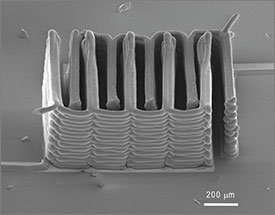Podcast: Play in new window
BOB HIRSHON (host):
Printing micro-power. I’m Bob Hirshon and this is Science Update.
Engineers are designing a variety of tiny useful machines, like medical devices that can travel inside the body, and tiny robots and sensors. But making batteries small enough to power the devices is difficult. In the journal Advanced Materials, Harvard scientists describe how they’ve printed batteries about a millimeter wide in interconnected layers. The stacked layers have more power than a single, thin battery and the printing process allows mass production.
In other tiny battery news, University of Maryland scientists report in the journal Nanoletters on a sodium ion microbattery they’ve made out of tin and wood. The flexible wood fibers can wrinkle and twist along with the tin that coats them, so the batteries don’t degrade as quickly as stiffer batteries. Both nanobattery projects are supported by the National Science Foundation. I’m Bob Hirshon, for AAAS, the science society.


